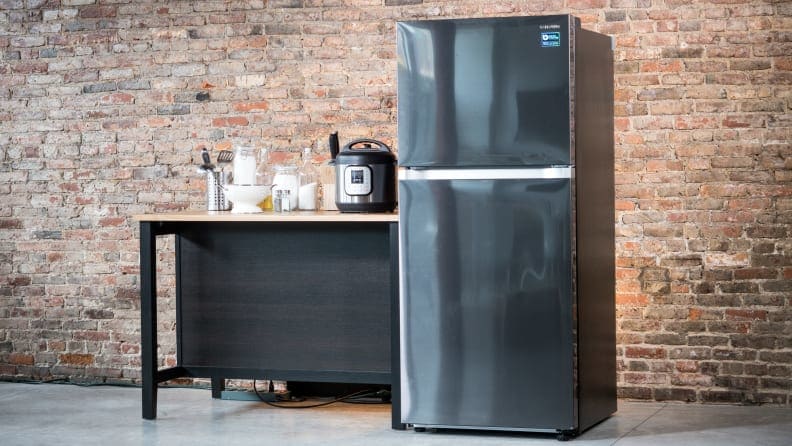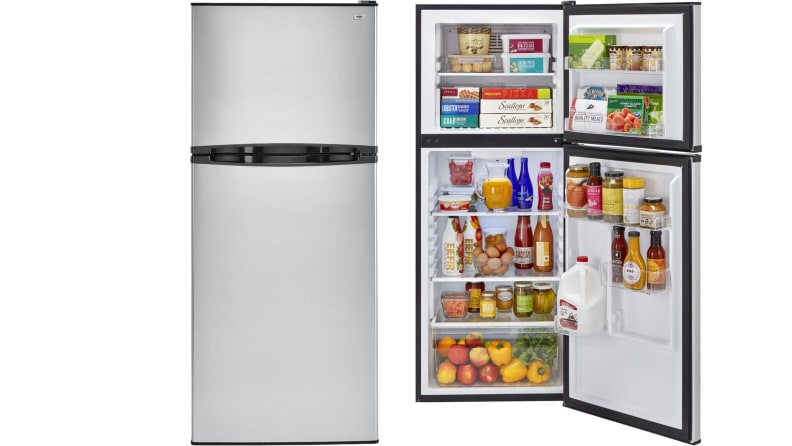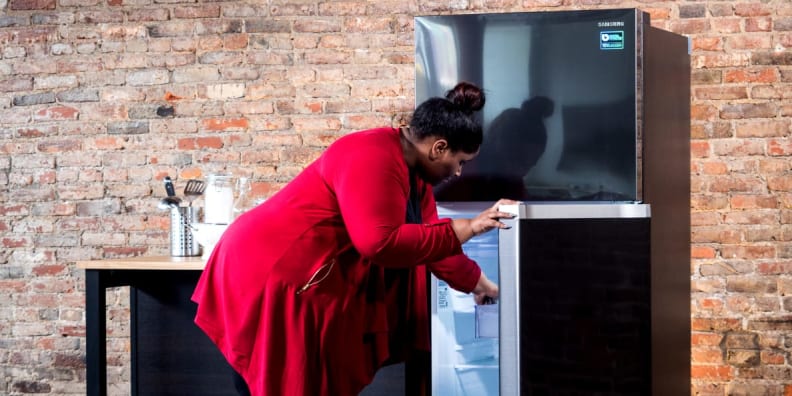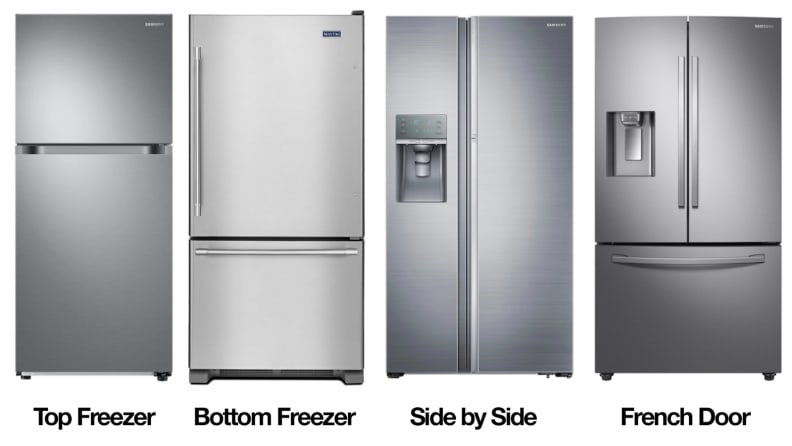The Best Top-Freezer Refrigerators of 2022
Posted by admin on
 — Recommendations are independently chosen by Reviewed’s editors. Purchases you make through our links may earn us a commission.
— Recommendations are independently chosen by Reviewed’s editors. Purchases you make through our links may earn us a commission.When you’re shopping for a fridge, a stroll through a home improvement store can be overwhelming. Surrounded by rows and rows of fridges that more or less look identical, it's easy to pick one at random—after all, they're just boxes that keep food cold, right?
In our labs here at Reviewed, our experts have tested hundreds of refrigerators, from French-door to side-by-side. While each style has its own set of technical pros and cons, there's also a subjective element to it, and that's based on what you need in your home.
We do have a ranked list of the best refrigerators we've ever tested. But, when it comes to top-freezer fridges, our favorite is the Haier HA10TG21SS (available at Best Buy for $629.99), which is a good fit for people who want steady temperatures at a bargain price.
Here are the best top-freezer refrigerators we've tested, ranked in order:
- Haier HA10TG21SS
- Insignia NS-RTM18WH7
- Beko BFTF2716SSIM
- Samsung RT18M6215SG
- Whirlpool WRT311FZDM
- Frigidaire FFHT1425VV
- GE GTS22KGNRBB
- Whirlpool WRT518SZFM
- Frigidaire FFTR1814VW
- Samsung RT21M6213SR
- Frigidaire FFTR2021TS
- Maytag MRT118FFFZ


If you’re in the market for an entry-level, counter-depth fridge, there are are fewer options better than the Haier HA10TG21SS top-freezer. This is a budget buy that offers an impressive performance for your initial investment. While its smaller stature means less storage space compared to a full-size model, it has impressive temperature performance and adjustable-height, spill-capturing shelves—two rare features to see in a fridge at this price point.
This fridge does lack some standard features, like a through-the-door ice and water dispenser or smart features, but the absence of those features lets this fridge shine at its very low price point. If you're looking for a basic fridge and didn't have much use for fancy features anyway, the Haier HA10TG21SS is one of the best values currently available.
Pros
-
Counter-depth
-
Steady temperatures
-
Great value
Cons
-
No extra features
-
Lower capacity


The Samsung RT18M6215SG is truly a unique top-freezer refrigerator. This 18-cubic-foot fridge has a sleek, black stainless-steel exterior and temperatures that are spot-on for food preservation.
Surprisingly, the most boring part of a typical refrigerator—the freezer—is where this fridge is truly innovative. The freezer can either be a normal freezer, or, with a few button presses, you can convert it into a second refrigerator zone. This can be a great choice for a small kitchen, a vacation home, or a garage or basement refrigerator.
We think that with its versatility and good looks, the Samsung RT18M6215SG is a better-than-average value.
Pros
-
Can maintain consistent temperatures
-
Flexible temperature zone
-
Black stainless steel finish
Cons
-
Have to stoop to access crispers
-
Not much in the way of storage
How We Tested Top-Freezer Refrigerators
The Testers
Hi there! We're Reviewed's appliance testing team. Between the us, we've spent years testing major appliances including washers, dryers, refrigerators, dishwashers, vacuum cleaners, and robot vacuum cleaners.
We have plenty of experience testing these products in the lab, but we've also used them as normal people would in the course of their daily lives, which means that we have a great sense for what appliances are bargains at their price points, and which appliances have really useful extra features.
The Tests
We test each fridge from two perspectives—first, from a data-driven, objective point of view, and second, as a regular person trying to get at the leftover Chinese food. The combination of these two types of experiences allows us to recommend the best fridge for you at any price point.
Refrigerators pull in air and cool it down to temperatures cold enough (usually around 37°F) to preserve food and limit bacterial growth. This cooling method means that fridges are very sensitive to air conditions. In hot weather, the condenser and cooling coils have to work harder to cool the warmer air. In cold weather, it may get so cold that the fridge condenser doesn’t turn on. This is why, if you happen to have a second fridge in your sweltering hot or freezing cold garage, you may have noticed that the air inside that fridge is not as cold as the air inside your kitchen fridge.
To avoid these temperature effects, we test each refrigerator in a lab that conditions the air temperature to 72°F +/- 5°F (basically, room temperature), and relative humidity to 50% RH +/- 15% RH. This way, each fridge can perform at its best, and doesn’t get penalized by dealing with warmer or colder air than its competitors.
We spend a week putting each refrigerator through its paces. We score over 50 aspects of fridge design and performance. After packing the fridge with water filled containers (since fridges operate better when there’s less empty space), we measure the fridge’s temperature, humidity loss, freezing time, usable space, and energy use.
- Temperature — Our ideal temperature settings for the fridge and the freezer are 37°F and 0°F, respectively. With fridge temperatures higher than 37°F, you may have to start worrying about bacteria growth, as 40°F is the start of the bacteria “danger zone”. Food isn’t properly frozen at freezer temperatures above 0°F. Once we set each fridge to those temperatures, we collect temperature data throughout the week’s testing that tells us not only how close the temperature in the fridge and freezer are to 37°F and 0°F, respectively, but how close the air temperature stayed to those ideal values.
- Humidity Loss — For this test, we focus on the refrigerator’s veggie crisper. We add water to a floral foam ball, and measure how quickly it dries. Humidity matters because if the crisper is too dry, your leafy greens will quickly dry out. If the crisper is too humid, your fruits will rot. Fridges that strike a balance between the extremes will preserve your fruits and veggies for longer.
- Freezing Time — Once the fridge is plugged in, we measure the time it takes for the freezer to cool down from room temperature to 32°F (the freezing temperature of water). This is a good measure of how quickly your fridge and freezer can cool down food or beverages that have just been placed inside the refrigerator.
- Usable Space — One of the most common refrigerator specs is the total capacity, or the volume inside the fridge, in cubic feet. You’d think that a higher capacity means more storage, but that’s not always the case as shelves, drawers, and ice makers can eat into that capacity. We measure the usable space, which is how much empty space is actually available in the fridge’s interior to store your food and drinks.
- Energy Use — Using an electric meter, we measure the fridge’s energy usage (in Watt-hours) over the week of testing. The less energy used, the more efficient that fridge is, and the more money it’ll save you on utility bills in the future.
We also use each fridge in a more casual sense so that we can answer usability questions about the fridge’s specs and features, like the doors, shelves, controls, water/ice dispenser, and extras like smart connectivity, door-in-door or flexible storage options, etc. If a refrigerator keeps the temperature at a perfect 37°F, but it’s very difficult to open the doors and the control panel makes no sense, we’re going to penalize that fridge with respect to its ease of use.
What You Should Know About Buying a Top-Freezer Refrigerator
If your refrigerator just died, chances are that you're in a hurry to replace it. But first, there are some things to know before buying a new refrigerator.

There are four main types of full-size fridges.
There are four major styles of refrigerator: top-freezer, bottom-freezer, French-door, and side-by-side. Top-freezer fridges are the most traditional and the most basic. They're also the least expensive.
If you’re reading this article, it’s because you are considering buying a top-freezer fridge, where the fridge door and the freezer door pulls open to the side.
Food Preservation
No one wants to spend hundreds or thousands of dollars on a refrigerator that can't keep your food cold. Preserving your food is, after all, its most important job!
You can look through our refrigerator reviews and our refrigerator roundups to see which did the best at maintaining the right environment for your cold foods and beverages.
Your Refrigerator Cutout
If you're replacing a fridge with a very specific cutout (usually surrounded by countertops and/or cabinetry), measure your cutout carefully—it's not unheard of for consumers to buy a beautiful new fridge, only to have to return it because it's too large for the cutout.
Measure the height, width, and depth of the cutout, then be sure to leave at least one to two inches between the top of the fridge and above-fridge cabinetry, as well as a couple inches between the back of the fridge and the wall. Leaving these extra inches is especially helpful for air circulation.
Lastly, when looking at the depth of your cutout, be sure to account for the depths of the fridge doors. If the distance your fridge sticks out from your cabinetry is not as wide as the thickness of the refrigerator doors, then you might not be able to open the fridge doors all the way.
Counter-Depth vs. Standard-Depth
The term “counter-depth” refers to the depth of your fridge—specifically, how much it sticks out past your cabinetry. The standard depth for a regular, full-sized fridge is typically about 30 inches. If your fridge is surrounded by cabinets, it probably sticks out anywhere from four to six inches. But, if you have space restrictions or stylistic preferences that tend towards a refrigerator with a shallower profile, you may want to take a look at counter-depth fridges.
While there's no standard depth measurement for counter-depth fridges (it largely depends on the manufacturer), they can be as much as six inches shallower than their non-counter-depth counterparts. What this means is that you lose interior storage space as a result of the shallower fridge profile.
One more thing to consider: Although it’s smaller, a counter-depth fridge may cost more than its non-counter-depth counterpart.
Storage Options
The most basic storage options include built-in shelves in the fridge, one or two crisper bins, and some shelving options on the fridge's doors. When it comes to extra storage, top-freezer refrigerators don’t get too exotic. Unlike French-doors, they’re ultimately basic fridges.
Efficiency
If the prospect of using less water and energy is appealing to you, consider the Energy Star rating for a refrigerator for an idea of what your utility bills might look like.
Typically, the more complicated your fridge (in features and design), the more energy it uses. In our experience, it's not a lot more than your more basic fridges, but it can add up over time. Only you can decide if the added convenience is worth the increase in running costs.
Fit and Finish
While you can still find black, white, and bisque refrigerators at most stores, stainless steel is a more popular style with modern consumers. Regardless, you should be able to find a refrigerator that matches your kitchen setup and your other appliances.
Price
Top-freezer fridges are among the most budget-friendly refrigerators on the market—most fall under or hover around $1,000—and that’s because they’re also the most basic. With this said, brands from LG to Hotpoint to Whirlpool to Beko to Smeg all carry top-freezer refrigerators.
Other Top-Freezer Refrigerators We Tested


Only available at Best Buy, the Insignia NS–RTM18WH7 refrigerator has one big thing going for it: a low, low sale price, which means it's cheaper than almost any other full-size fridge you can buy.
This fridge was one of the most efficient fridges (in terms of electricity usage) that's ever come through our labs. On the other hand, the 18-cubic-foot top-freezer had a tough time with some of our tests. Namely, it ran a little hot, with temperatures well above our preferred value of 37°F. Bumping the temperature down to the lowest setting will ensure that your food is being safely preserved.
There's also plenty of storage space, with no hidden extras (like water filters or air filters) to take up valuable real estate that you need for a pizza box or a Thanksgiving turkey.
Long story short, we think the Insignia NS-RTM18WH7 is worth a look if you need a second fridge or if your budget is tight.
Pros
-
Energy efficient
Cons
-
Fridge temperatures can run a little warm


The Beko BFTF2716SSIM combines a great look with some solid performance in a compact package. This top-freezer has few frills, just an internal ice maker, some nice spill-capture glass shelves, and interesting crisper tech that could extend the shelf life of your leafy greens.
Beyond that, this is just a basic fridge with some seriously stable temperatures. You will need to calibrate its freezer before use, but considering what this fridge offers for its purchase price, we think that's a small sacrifice to make for such steady cooling.
This fridge is on the smaller side, even compared to other counter-depths, so if space in your home is tight, it makes for an excellent budget buy. Of course, the downside of its smaller footprint is lower overall storage capacity. We'd recommend this one for anyone living on their own or with maybe one other person—any larger households might find this one a bit cramped.
Pros
-
Steady temperatures
-
Inexpensive
-
Interesting crisper tech
Cons
-
Low overall storage
-
Freezer requires calibration

While imperfect, the Whirlpool WRT311FZDM is a fantastic deal. Our tests show this fridge is one of the most efficient available, and it is more than adequate when it comes to preserving food. Temperatures are stable, energy consumption is low, and it makes great use of the available space. It also looks really good for its price.
However, its crispers aren't great, and you’ll want to turn down the thermostat, but if you’re looking to keep costs low and don’t need a pre-installed ice maker, you can't go wrong with this fridge. Whether you need a replacement unit for the kitchen or an attractive second fridge, this Whirlpool is a great bargain.
Pros
-
Energy efficient
-
Glass shelves
Cons
-
Fridge temperatures can run a little warm


Top-freezer refrigerators may not experience the fanfare of their modern French-door counterparts, but this fridge is proof they can still hold their own in the kitchen. The Frigidaire FFHT1425VV is an impressive fridge for its size. While it's about 50% the size of a typical refrigerator, it maintains a fairly high capacity—certainly enough for a couple or small family to store food without issue.
The EvenTemp Cooling System keeps fridge temperatures consistent, fluctuating only one-tenth of a degree in our tests.
If you’re looking for a small, affordable fridge for an apartment or a garage, the Frigidaire FFHT1425VV may be the perfect pick. Not only does its small size ensure it’ll fit in more locations, but we saw great temperature consistency throughout the fridge and freezer. It’s incredibly energy efficient as well, using about half as much energy as the average fridge.
Pros
-
Great size for smaller spaces
-
Good temperature consistency
Cons
-
No ice maker

If you want a solid, no-frills fridge, the GE GTS22KGNRBB is a great choice.
While some fridges try to cram in every available extra feature and sometimes need to make trade-offs for performance, the GE GTS22KGNRBB instead focuses on the basics—and does a great job. It doesn’t have some of the usability features we like to see, like flexible shelving or storage options, but it is capable of maintaining steady, cool temperatures.
While the GTS22KGNRBB is a bit more expensive than other bare-bones fridges we've reviewed, it doesn't have other typical problems we see—like inconsistent temperatures. If you're looking for a garage fridge or need to maximize your budget, the GTS22KGNRBB is a pretty good value for what it offers.
Pros
-
Maintains stable temperatures
-
Large freezer
Cons
-
Freezer runs a little warm on the default setting

The Whirlpool WRT518SZFM top-freezer fridge is a pro at maintaining steady, cool temperatures—a huge bonus, since this is a trait that many similarly-priced refrigerators just don't have. Additionally, the WRT518SZFM features more customizable storage options than its competition.
While we liked the cooling performance and storage options for a fridge at this price point, it’s still pretty basic, although an excellent choice. If you want dispensers or smart features, this isn’t the right fridge for you.
Pros
-
Steady temperatures
-
Good storage options
-
Good value for its performance
Cons
-
Light on features
-
Recommended temperatures run warm

Sometimes you just need a basic refrigerator without all the bells and whistles, and the Frigidaire FFTR1814VW doesn’t have much in the way of extra features, like an ice dispenser or flexible storage options, but it does have some very stable temperatures for its price. The interior features are also minimal—simple wire racks and in-door bins.
The Frigidaire FFTR1814VW is the definition of a solid, spartan, affordable fridge.
Pros
-
Solid, consistent temperatures
-
Inexpensive
Cons
-
Bare bones
-
No dispensers
-
Limited storage options

This top-freezer refrigerator offers a beautifully sleek look with its pocket handles and fingerprint-resistant stainless steel finish. The freezer can also double as a fridge.
During testing, this fridge showed spot-on temperatures. We set all the fridges in our labs to 37°F and monitor the temperature variance. The RT21M6213SR, over the course of 72 hours, averaged 37.6°F—excellent for food preservation.
Pros
-
Maintains consistent temperatures
-
Flexible temperature zone
Cons
-
Small crisper drawers

If you’re looking to replace your current fridge at an affordable price, or are in need of a second fridge for your home, the Frigidaire FFTR2021TS is a solid option. Not only does it offer slightly more storage space than the average top-freezer, but it also does a reasonable job maintaining humidity, and it's relatively energy-efficient to boot—which is more than we’d expect form a fridge in this price range.
Unfortunately, that doesn’t mean the Frigidaire FFTR2021TS necessarily rises above some of the common pitfalls of inexpensive fridges. Namely, it has some difficulty maintaining lower temperatures in its freezer and runs a bit warm on the suggested settings. But, as long as you know to manually turn the temperature down a bit to account for this Frigidaire's tendency to run warm, you should be happy with its performance.
Pros
-
Affordable
-
More storage space than average
Cons
-
Difficulty maintaining low freezer temps

The Maytag MRT118FFFZ is one of the least expensive stainless steel refrigerators we've seen. Efficiency is this refrigerator’s strong suit. It uses power like a miser. But—and there's no positive way to spin this—the fridge can't maintain its temperature. It fluctuates by about 1.5 degrees, whereas most refrigerators we've tested might waver by about .3 degrees. The refrigerator compartment runs cold, while the freezer runs warm.
This is not a model we highly recommend.
Pros
-
Energy efficient
Cons
-
Can't maintain temperature
